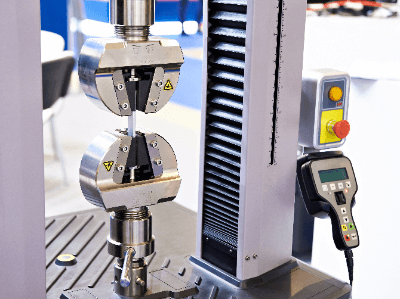What Is a Load Testing Machine?

A Load Testing Machine is a testing device used primarily to determine the strength of materials.
For many of the tests performed in a Load Testing Machine, a test piece is fabricated for the test. Load testing machines typically apply a vertical movement to the specimen in tension, bending, compression, or shear to determine the deformation, elongation, or rupture behavior of the material under load.
Load Testing Machines are also commonly referred to as universal testing machines by some testing equipment manufacturers. Load Testing Machines are mainly used by companies, research institutes, and universities in various industries, including the mining industry.
They are useful for testing the mechanical properties of a wide range of materials, including metals, non-metals, composites, pharmaceuticals, food, wood, copper, aluminum, plastic profiles, wire and cable, paper, film, rubber, and textiles.
Applications of Load Testing Machines
Load Testing Machines are widely used in quality control and research and development. They are used to check the strength of welding, brazing, and bonding, as well as to examine the properties of certain materials.
The demand for measurement technology using Load Testing Machines by industry is very diverse, including automobiles, aircraft, railroad vehicles, food and packaging, textiles and clothing, electronic components and electrical equipment, construction and furniture, cosmetics, medical equipment and pharmaceuticals, sports, and factory management.
In particular, for aircraft, Japan requires certification that the structure and strength of a designed and manufactured aircraft conform to the requirements and standards of the Civil Aeronautics Law related regulations called the “Airworthiness Examination Procedure”. For this purpose, load testing of the aircraft structure on the ground is rigorously conducted.
Principle of Load Testing Machine
Load Testing Machines (universal testing machines) are mainly electronic, hydraulic, or both, depending on the drive source.
The Load Testing Machine has two vertical threaded shafts through which slides a movable crosshead. For tensile testing, the material specimen is placed between the crosshead and the movable head jaws; for compression testing, the material specimen is placed between the movable head and the table.
The Load Testing Machine has a speed controller, which controls the speed of the two vertical threaded shafts. As the movable crosshead moves, the load applied to the material specimen changes. The relationship between the magnitude of the changing load and the amount of deformation can be recorded and charted to show the strain characteristics of the material under load.
Structure of Load Testing Machine
The Load Testing Machine is composed of five major elements.
1. Load Frame
The load frame is the framework that supports the specimen under tension or compression. Since the Load Testing Machine sometimes detects slight plastic deformation of the specimen, it has sufficient rigidity for the test load.
2. Load Cell
The load cell is a sensor that detects the load applied to the specimen and is usually mounted on the top, movable head of the testing apparatus. The load cell is a sensor that detects the magnitude of the load as an electrical signal by means of a strain gauge. To obtain correct test results, load cells must be calibrated periodically.
3. Locking Clamp
Locking clamps hold the specimen in place so that the load is applied to the specimen. Multiple fixtures can be mounted to secure different types of materials and specimens.
4. Strain Detection
For example, in a tensile test of a material, the applied load and the elongation of the specimen must be accurately measured. Strain detection detects the amount of deformation with an accuracy of 1μm.
5. Control Unit
In load testing, the rate of change of the load applied to the specimen is also important. The control unit controls the load to be applied according to the test conditions. It also records the magnitude of the load and strain applied.